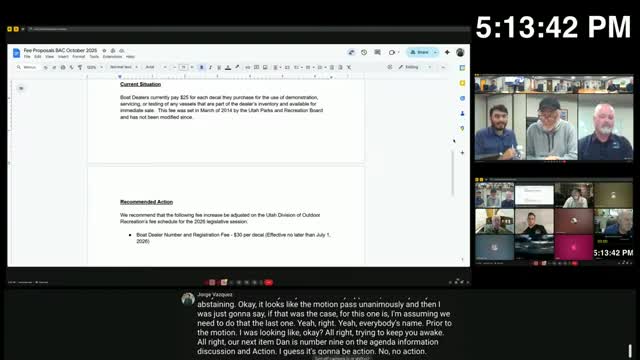Council debates proposed loosening of life-jacket requirements; public safety groups urge keeping current rules
October 22, 2025 | Utah Recreational Trails Advisory Council, Boards and Commissions, Organizations, Utah Executive Branch, Utah
This article was created by AI summarizing key points discussed. AI makes mistakes, so for full details and context, please refer to the video of the full meeting. Please report any errors so we can fix them. Report an error »

Division staff brought council members an inquiry from a legislator about loosening Utah's life-jacket wear requirements for some waters. Ty Hunter and other staff discussed options for changing the administrative rule, including (a) zoning specific river reaches as "non-wear" sections or (b) revising the statewide rule to require wear only on waters that county sheriffs or other local authorities designate as hazardous.
Staff cautioned the council that reclassifying large numbers of river miles or delegating wear requirements to many counties would be administratively complex, could create enforcement confusion and might increase risk. Staff emphasized the department had moved away from subjective river class ratings to clearer "flat water" delineations to make compliance and enforcement more consistent.
Council members and several advisors said the current framework appears to be working and expressed concern about increasing drownings if requirements are relaxed. Members asked for data; staff and public commenters provided casualty context during the meeting. Michelle Christiansen of the Utah Drowning Prevention Coalition told the council that nationally 75% of recreational boating deaths are drownings and that a high proportion of victims are not wearing life jackets; she cited Utah data showing 10 drowning deaths so far this year with nine victims not wearing life jackets. Trish Hull, chair of the Utah Drowning Prevention Coalition, and other public speakers urged keeping the current rules, pointing to recent drownings on reservoirs and rivers where conditions changed quickly.
Council members also raised operational concerns: stand-up paddleboards and other new craft are increasing on lakes and rivers; enforcement and public education would be difficult if wear rules were relaxed. Several outfitters and river operators said insurance and carrier requirements could still require life jackets even if rule changes were made.
No motion or formal rule change was made at the meeting. Staff recorded council feedback and public testimony for use should the Legislature or staff pursue any future rule amendments.
Staff cautioned the council that reclassifying large numbers of river miles or delegating wear requirements to many counties would be administratively complex, could create enforcement confusion and might increase risk. Staff emphasized the department had moved away from subjective river class ratings to clearer "flat water" delineations to make compliance and enforcement more consistent.
Council members and several advisors said the current framework appears to be working and expressed concern about increasing drownings if requirements are relaxed. Members asked for data; staff and public commenters provided casualty context during the meeting. Michelle Christiansen of the Utah Drowning Prevention Coalition told the council that nationally 75% of recreational boating deaths are drownings and that a high proportion of victims are not wearing life jackets; she cited Utah data showing 10 drowning deaths so far this year with nine victims not wearing life jackets. Trish Hull, chair of the Utah Drowning Prevention Coalition, and other public speakers urged keeping the current rules, pointing to recent drownings on reservoirs and rivers where conditions changed quickly.
Council members also raised operational concerns: stand-up paddleboards and other new craft are increasing on lakes and rivers; enforcement and public education would be difficult if wear rules were relaxed. Several outfitters and river operators said insurance and carrier requirements could still require life jackets even if rule changes were made.
No motion or formal rule change was made at the meeting. Staff recorded council feedback and public testimony for use should the Legislature or staff pursue any future rule amendments.
View full meeting
This article is based on a recent meeting—watch the full video and explore the complete transcript for deeper insights into the discussion.
View full meeting

